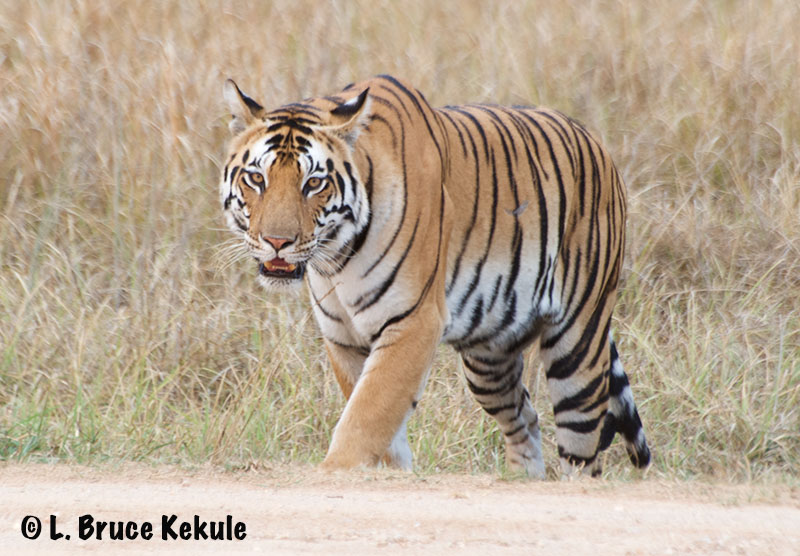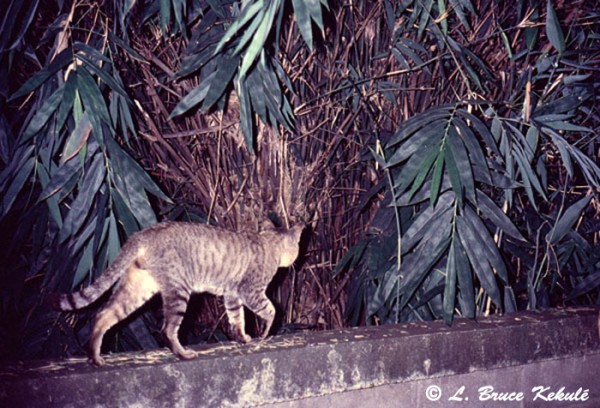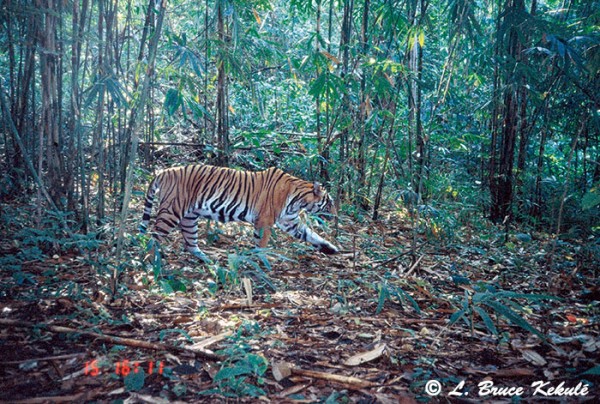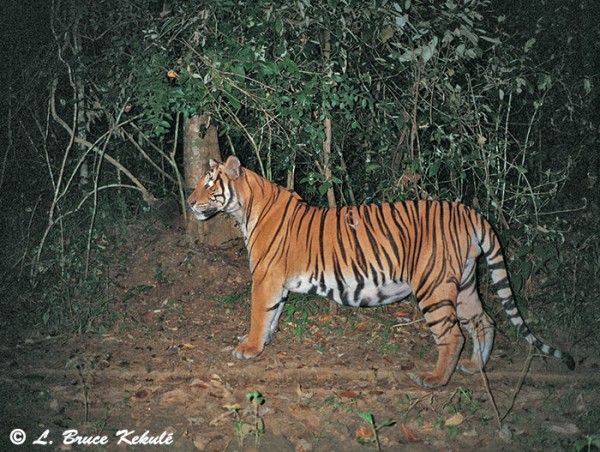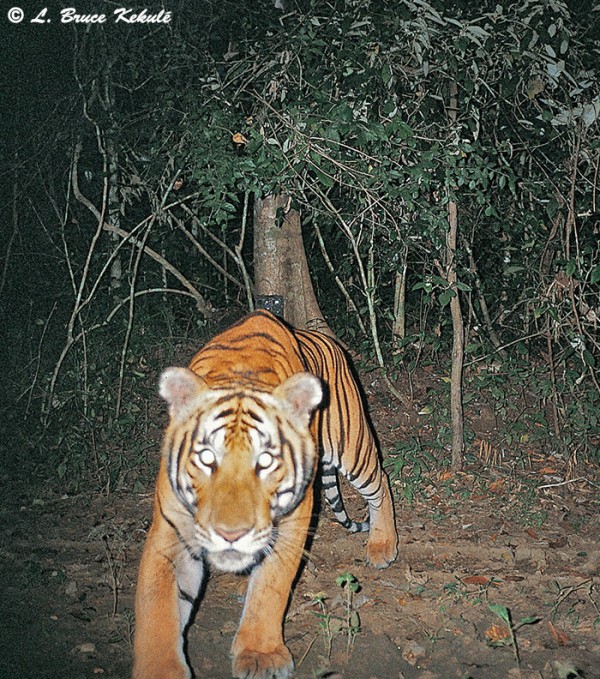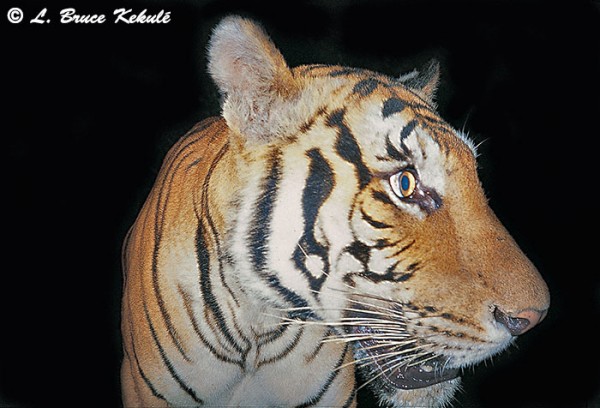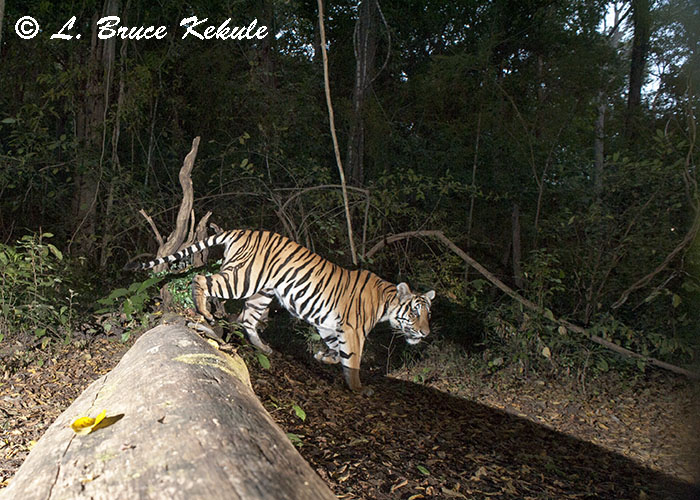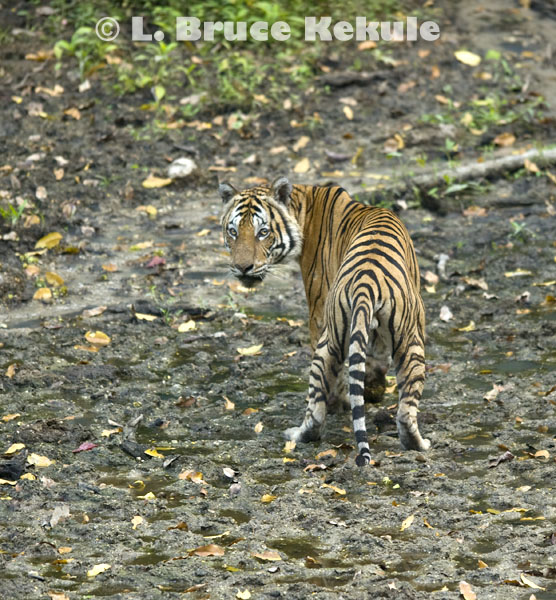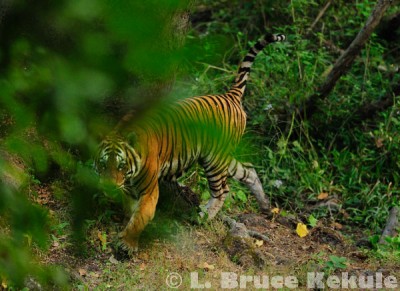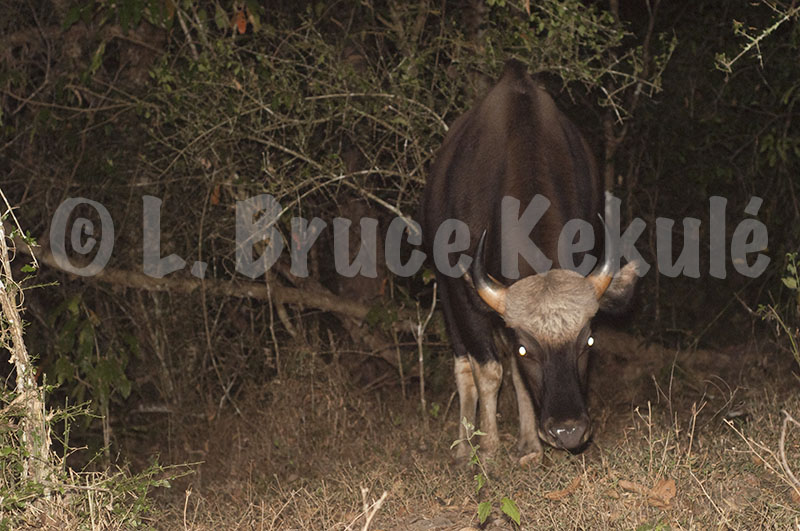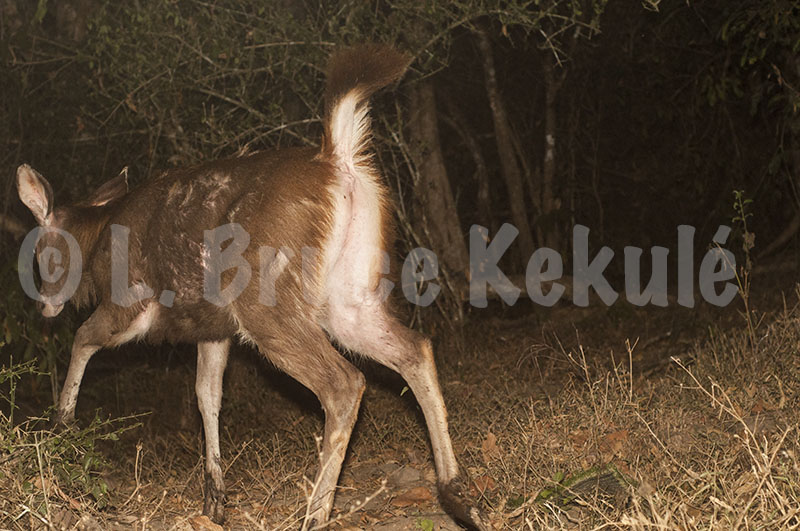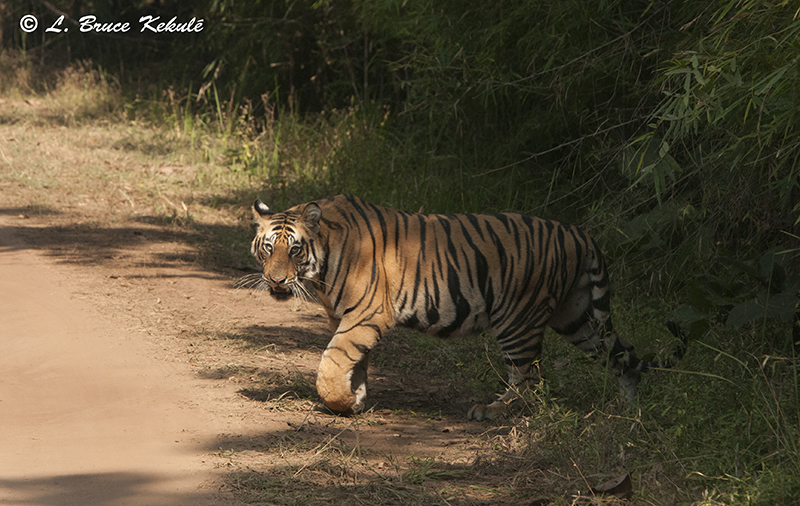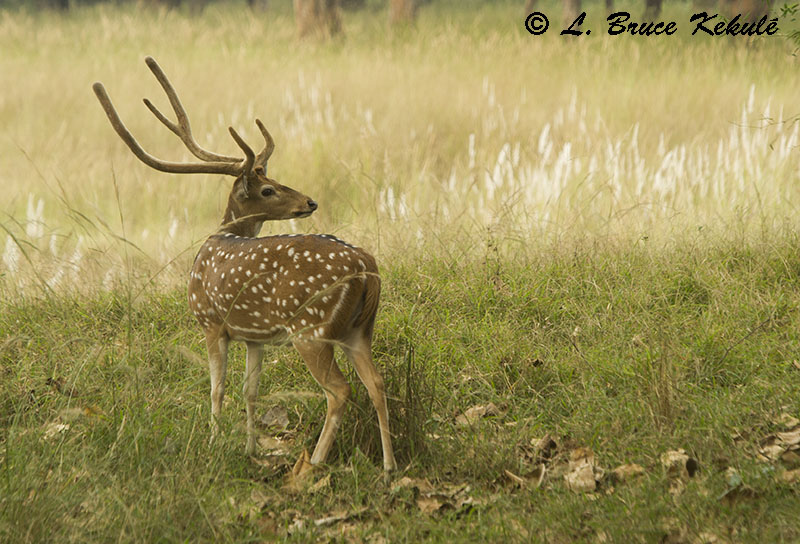Posts Tagged ‘tiger’
Kanha National Park: The best run protected area in India
A tiger reserve in Madhya Pradesh
‘Jamun Tola Male’ or T-24 drinking at a small natural waterhole early in the morning…!
If someone ever has an urge to visit one of the best ‘tiger reserves/national parks’ in India, pick Kanha in the southeast of Madhya Pradesh State. The forest department is commended for improving the visitation to the park by both local and international tourists, and my hat is off to them for implementing some great new measures.
‘Naina Female’ or T-76 coming straight at us…!
They have made it a regulation that all forest guides be equipped with a GPS (actually a smart phone with a GPS App.) The authorities can now check the speed limit which is 20 kms per hour and is strictly enforced. If a jeep goes off track or goes too fast, a tough lesson will be learned by both the driver and the guide. It is now very well organized and they pay attention as some have already been red-carded for excessive speed and other infringements. That means anywhere from a seven to fifteen-day suspension, or even longer. The drivers/guides now pretty well toe the line which keeps the dust down, and is much safer and more enjoyable then previously…!
T-24 crossing the road…!
While I was there this past February, sightings were down a bit but the department is creating fire lines by burning fallen leaves on the side of the road that somehow effects tiger sightings. I experienced this same thing in Pench National Park last year where they were doing the same thing burning leaves but now I realized for a good reason. I did not really think about it at the time and did not get any tiger sightings, but did hear several tigers roaring in the dense forest. The big cat just moved away from the road temporally. March is when they expedite this safety program to keep forest fire down to a minimum.
T-76 in the late afternoon just before closing time..!
However, I did get two tigers this time shown here; a female known as T-76 or ‘Naina’ in the afternoon as we were heading back to the gate. We stopped at a T-junction for few minutes and she popped out of the grasslands in front of us for some really great head-on shots. Then the next morning as we were motoring around, we bumped into a bunch of jeeps parked along one side of the road. We slipped into a space and were there for 10 minutes when a male tiger was seen rustling in the bushes directly across from us. He then sauntered down to a natural spring and stayed at the waterhole for more than 10 minutes slurping up a needed drink. I kept on shooting until he moved and in a few minutes, he popped out on the road and as he crossed, I got some good flanking shots of ‘T-24’ known locally as the ’Jamun Tola Male’…I was elated to say the least…!
So, my recommendation is: if you want a great visit with the possibility of seeing a tiger, go to Kanha as it is well worth the trip. Again, well done Forest Department Director Dr Sanjay Kumar Shukla IFS Field Director Kanha Tiger Reserve and staff, and I look forward to future visits to India’s best run tiger reserve and national park. Every park in the country should now take note and follow suit, as most of the other ones continue to have serious problems with jeeps racing for position, and absolute mayhem when tigers are spotted. This will be tough to implement but given time, I’m hoping things will get better in the other tiger reserves scattered throughout India.
Nikon D700 catches an Indochinese tiger
A female tiger returns again…!
About five months ago, I set a Nikon D700 DSLR camera trap at a hot spring deep in the interior of the Western Forest Complex of Thailand. I managed to get some nice shots of a female Indochinese tiger as she walked back and forth, and up and down to the mineral seep. I then moved the D700 to another tree close by for a better capture and composition. When I got to my camera last week and checked my files on the Nikon, I almost fell off the log I was sitting on. There she was again but this time with expression, behavior, focus and exposure perfect. This shot is one of my best all time tiger camera trap images….great success at last at this new location…Enjoy…!
Camera: Nikon D700 full-frame body
Lens: Nikon 35mm manual lens (very old)
Sensor: Snap Shot Sniper SSII
Case: Pelican 1150
Box: Aluminum ‘elephant proof’ housings for camera, flashes and sensor
Flashes: Two Nikon SB-28s
Exposure: 1/200th – ƒ5.6 – ISO 400
The first shot in the string…!
Indochinese Tiger: How I capture tigers on film and digital
|
“This is an old post but I thought it would be good to re-cap my work over 20 years with the tiger” Notes from the field: The wizardry of modern technology |
Tiger posing in a waterhole in the Western Forest Complex of Thailand…!
I arrived in Thailand in 1964 and took an immediate liking to the wildlife and forests of the Kingdom. Since then I have consistently visited many wilderness areas, and I can say the tiger is the most difficult of all the Asian creatures to see or photograph. I have only seen two tigers in all those years although many have been seen on my camera traps. Also, I have come upon many tracks left by the big cats. These magnificent carnivores are now rare and hence, very difficult to capture on film and/or digital. However, the wizardry of modern technology has given me an edge.
Male tiger camera trapped in the Western Forest Complex
My first sighting of a tiger was in Sai Yok National Park in Kanchanburi province along the western border with Burma more than 15 years ago, and my second in Huai Kha Khaeng Wildlife Santuary in Uthai Thani province just last year. Western Thailand is probably the best place where tigers can be seen in the wild. Luck would have to be the number one element but photo equipment, know-how and location also come into play.
Tiger camera-trapped at night by the Phetchaburi River in Kaeng Krachan National Park
The first was a fleeting glimpse of tiger deep in the forest of Sai Yok Natonal Park in Western Thailand as I was sitting in a tree blind overlooking a large stream and mineral deposit, waiting for gaur that never came. Early one morning, I heard an animal jumping across the stream behind me. I took a quick look back and saw a sleek cat slide down the opposite bank. I went down at noon and looked at the tracks left neatly in the sand but quickly went back up. It was a close encounter with a real wild animal capable of taking man down in a split second. As I was up in a tree, I assured myself I would be safe.
A collard tiger in the Western Forest Complex camera trapped on a forest road
After that, the urge to capture a tiger on film became an obsession and I finally decided to build my own camera-traps. I had the basic machining skills acquired after almost two decades of working as a rig mechanic in the oilfield, and before that the logging and heavy equipment industry. I have a small machine shop with a milling machine and assorted tools at home in Chiang Mai. I used a commercial camera-trap as the basis for my homemade ‘game or trail cameras’ as they are now called in the U.S. where a big business is flourishing..!
Tiger camera-trapped during the day by the Phetchaburi River in Kaeng Krachan
Tiger camera trapped along the Phetchaburi River in Kaeng Krachan My first camera-traps used passive infrared sensor boards purchased from ‘Radio Shack’ while I was back on vacation in the States. My close friend Yuthana Anantawala from Chiang Mai was working for Unocal in the Gulf of Thailand as an electrician, and he helped me wire up several ‘point & shoot’ film cameras to the electronic boards. I built the housings out of ‘TIG’ welded aluminum boxes and machined the case flat to incorporate a face-plate attached with machine screws for a tight seal.
Sealing and protecting the delicate electronics of the camera, board and batteries against moisture was the number one priority; silicon sealant forms a gasket to seal the case and is available everywhere, and silica gel (desiccant) in a small plastic bag to absorb any moisture was the trick. The first ones were simple and worked quite well. I tested them out the back of my shop where domestic and feral cats walked on a wall.
A feral cat walking the wall behind my shop testing a film camera-trap
In mid-2003, I set six camera-traps in Sai Yok along wildlife trails and waterholes. After four months, I finally got my first tiger, and then a second cat a few days later up on a 600-meter ridgeline. It was the beginning of a program to catch the striped cat on film. Other animals caught were elephant, sambar, barking deer, wild dogs, wild pigs, serow and stumped-tailed macaque. I even managed to catch a water monitor on one camera.
Notes from the field: My lucky number eleven.
When you play the dice game ‘craps’, the number eleven is a winner for money, but you loose the dice and the next throw. The following story is about my ‘number eleven’ – two very lucky photographs, but getting them almost cost me my life. It was November 2003 while working in Sai Yok. My team and I had just set a string of camera-traps deep in the interior of the protected area. As we were leaving camp, the cook asked me for a lucky number. I had just lifted my camp chair, which left an impression in the soft dirt like the number eleven, and so I shouted out to the boys that the lucky number was eleven.
A male tiger camera trapped with film in Sqai You National Park, Western Thailand
However, just after that, I became ill with the deadly Plasmodium falciparum (cerebral malaria) that almost killed me. The only thing that saved me was a medical procedure practiced here in Thailand for patients with severe malaria called a ‘blood exchange transfusion’. I stayed in the hospital for nine days and it was a slow recovery. I was lucky to survive. I will write a thread about that ordeal one day for Camtrapper and all the dangers of working in a Thai forest.
Some may argue that it was just a coincidence that 11 was recorded on both shots, but I like to believe the ‘spirits of the forest’ had finally answered my prayers. Ever since then, my luck has been a great roller-coaster ride in the exciting field of wildlife photography, publishing three coffee table books in English and Thai. Wild Rivers, my third book project, is just a continuation of a dream I had in Sai Yok more than 20 years ago, but that is another story.
A male tiger camera trapped on an old logging road in Kaeng Krachan
In 2004, I moved further south to Kaeng Krachan National Park in Phetchaburi province, Southwest Thailand and began a new program with some generous financial support from World Wide Fund for Nature (WWF-Thailand) and in cooperation with the Department of National Parks (DNP). A presence/absence program was initiated at two areas in the park.
The same tiger as above walking towards the camera
Within a few months, I managed to catch a big male tiger and several leopards on an old logging road about 10 kilometers from the main gate. The other area was along the Phetchaburi River deep in the interior.
The same tiger as above taking a real close-up
Over a period of three years, both cat species were caught on film in Kaeng Krachan consistently. The felines were in abundance. Leopards in both black and yellow phase were captured. The tiger and leopard have overlapping territories and hunt during the day and night.
Tiger named ‘4-spots’ camera-trapped in many areas of Kaeng Krachan
One tiger named ‘4-spots’ was consistently trapped in many areas of the park. I also managed to photograph a fishing cat, a rare occurrence. Other animals trapped were elephant, gaur, sambar, Fea’s muntjac, common muntjac, sun bear, banded linsang and striped palm civet among others like Indian civet, porcupine and fish-owl.
A first record of a tiger in a mineral deposit in Kaeng Krachan
It was a tremendous experience seeing all these exotic animals thriving in their natural habitat, and I looked forward to scrutinizing every roll of film. But it must be mentioned that there were many failures with equipment and even theft. I lost four cameras in Kaeng Krachan to poachers that probably had their photo taken and scared them. They actually bashed them until they busted open and chopped one out of a banyan type tree root. I dropped the program, as it was a very expensive loss including the cameras, gas, food and labor, plus whatever photos were lost. I do plan on returning to the Phetchaburi River one day but with much more robust camera housings hopefully to prevent further loss.
A male tiger with a collar camera trapped at night on a forest road in the Western Forest Complex
I then moved to Huai Kha Khaeng Wildlife Sanctuary in Western Forest Complex-Thailand hoping to put my traps to work in a more tightly protected area. It did not take long to capture tiger and leopard, plus gaur, banteng, tapir, elephant, and many other creatures living in this World Heritage Site. And, I have finally lost two cameras to theft. From time to time, I still set traps in the sanctuary always hoping for a magical sighting of the big cats and other wonderful animals found here.
The same tiger as above but with a Sony DSLR camera on another date
Finally, the ‘digital camera-trap’ age has arrived. In November 2008 armed with a new digital camera-trap, a tiger (above) was caught in a salt lick not far from the main gate in Kaeng Krachan. It was an early morning shot of a mature cat and the first record of a tiger in a mineral deposit in the park. Prior to that, it was always thought the predator hunted around the peripheral of mineral licks that attracted the herbivores.
A young male tiger crossing over ‘tiger log’ in the Western Forest Complex
Kaeng Krachan and Kui Buri national parks have Thailand’s second best population of tigers and leopards, and both remain some of the top protected areas where they still survive and breed. I have left the Southwest are of Thailand and moved up to the Western Forest Complex.
There are three companies in the United States that specialize in passive infrared boards, and one company that offers active infrared controllers. I have listed web-address at the end of this thread in the event someone has a hankering to build a homemade camera-trap. The websites are very informative but it does require some extensive searching to get good information. Instructive data on modifying cameras and building your own camera-trap is listed.

A young female tiger with a collar crossing over ‘tiger log’
It is not easy anymore finding the right secondhand point-n-shoots like Sony, Nikon, Olympus or Pentax digital models at used camera shops or pawnshops anymore. They do float in and out of one place at the very end of Chinatown’s Yawalat Road on the right hand side of the road that sells second hand camera and video stuff. Make sure you thoroughly check the camera out, and even then, it might turn into a dud. The most popular camera for trail units is the Sony S600 digital with a 6-megapixel sensor and a Carl Zeiss lens. They take very good daytime photos and fair pictures at night.
A tiger camera trapped and squinting due to the camera flashes (2nd shot)
There is of course no warranty after a camera has been ‘hacked’; the terminology used for a camera wired up to a sensor board. And finally, many cameras do not work; only a few models listed by the board manufactures do. It takes skilled electrician lots of intricate work to get these boards and cameras working properly. I have spent loads of time and money on building camera-traps, but also have collected a large library of images of some very interesting, elusive and endangered animals to compensate the cost.
Notes from the field: “A tiger through the lens, and my lucky number 11”
A male tiger walking into a waterhole in the Western Forest Complex on Dec. 11, 2009
The same tiger taking a quick drink from the seep that is visited by many mammals
Good things sometimes come our way and I was about to get a reward to coincide with ‘2010 – The Year of the Tiger’. The absolute chronology of being at the right place, the right time with the right equipment and the right technique was played out before my eyes. On the 11th of December 2009 (my lucky number again), the tiger in the lead photo and I crossed paths.
Taking a quick look back at me in the photo-blind
The trail through dry dipterocarp forest takes about 45 minutes to walk to a photographic blind set above a waterhole deep in the interior of Huai Kha Khaeng. The flimsy structure made of bamboo sits about two meters off the ground and is attached to a tree. Black mesh closes off the cubicle on all four sides that was erected by the park rangers. An opening large enough for a big lens allows a clear view of the waterhole some 30 meters downhill to a saucer shaped depression.
This water supply attracts many creatures such as elephant, gaur, banteng and other ungulates like sambar and wild pig, especially during the dry season. Tiger, leopard and Asian wild dog also come looking for prey. It is truly a magical place and a tribute to Thailand’s natural biodiversity. Arriving about 12pm, I immediately set-up my cameras and then waited. Feeling dozy about 2pm, I strung my hammock for a bit of a snooze after the long haul from Bangkok. The afternoon passed-by and about 5pm I got up and began a vigil of the mineral lick.
the same tiger as above on the move.
A few minutes later I decided to actually sit behind my Nikon 400mm f 2.8 lens and D700 camera, and do some adjustments to compensate for the fading light. Took a few test shots to make sure the exposure was correct and then waited. Two minutes later, the dream of a lifetime unfolded before me. A striped carnivore magically and silently appeared from the forest on my right. The tiger walked straight down to a little stream for a quick drink. The mature male did not linger and continued on his way. However, he did pause briefly to stare up at my position three different times before disappearing into the forest on my left. Total time spent by the cat at the waterhole was less than a minute. He then circled my position and growled at me from where he had entered the waterhole; now that was exciting..!
A last look; he then circled my position and growled at me as a warning
I was lucky to have been sitting down with my hands on my lap in front of my camera. If I had been standing, or made just the slightest noise, I would have never seen this old male. I was extremely fortunate to snap 20 frames as this magnificent creature carried on its way. I banged my head against my camera in disbelief to make sure I was not dreaming. The ultimate photograph for me was now in the bag so to speak.
Notes from the field: Camera equipment and technical elements
In order to photograph these elusive predators or any other large mammals or birds for that matter, a large lens (400mm to 600mm) and a semi-pro to pro camera body from any of the big guns like Nikon, Canon, Pentax, Olympus, Sigma and Leica is needed. A tripod and a shutter release is an absolute must for sharp shots. It must be understood though that this equipment is expensive.
I set my Nikon camera to aperture priority (auto), an appropriate ISO depending on the time of day or the light (normally 400 ISO), and the white balance to ‘cloudy’ with an f-stop of ƒ5.6 to ƒ8 with minus -7 compensation. This gives me a good starting point and I can quickly change these settings or compensation for the ever-changing light in the forest.
After 20 years of wildlife photography, my aspiration to photograph a tiger through the lens has finally come true. However, in closing and it does need repeating; the powers to be (the government) must come up with much better management plans for saving not only the tiger but all the rest of wild animals and ecosystems that evolved over millions of years. It is hoped my photographs of the tiger and other amazing Thai animals will create conservation awareness, so that the destructive process of modernization and humanization can be slowed if not stopped. The Kingdom’s natural resources are irreplaceable and time is running out!
Camera-trap units and equipment manufacturers:
The following companies specialize in camera-trap electronic infrared boards plus equipment, complete units and knowhow (listed below). I recommend these as the best but there is a rip-off or two with loads of empty promises, lots of jargon and does not deliver on their promises, so beware. Due to possible litigation, I am not at liberty to say who they are so please do not ask. When you see a lot of rambling on about how good they are, think before buying. I know because they burned me with boards that did not work and then would not be responsible for the poor quality and/or replacements. There are also complete camera-trap units available from quite a few manufacturers but are quite expensive for the good ones. The cheap ones do not stand up to the tough conditions of most Thai forests. Importing them into Thailand can also be costly with shipping and taxes. The main reason why I build my own.
Passive infrared boards:
http://www.snapshotsniper.com and http://www.rcdavisgamecamerasolutions.weebly.com/
Completed camera-trap units are also available: For an in depth overview on trail cameras check out ‘Trailcampro.com’
Moultrie.com – Cuddleback.com – Bushnell.com – Browning. com – Reconyx.com (the quickest trail camera on the market) are just some of the makes and many others via for market share.
Some final words: If you live near a forest in Thailand or anywhere in the world, chances are there might be some cryptic wild species still living there. But unfortunately, domestic plus feral dogs and cats can be found in many of these small patches of wilderness, and take everything they can catch and eat. I once camera-trapped feral dogs at 2,300 meters above seal level in Doi Inthanon National Park in Chiang Mai, Northern Thailand. It was a very disappointing discovery, and I only felt remorse for all the beautiful creatures struggling to live in this high-montane forest.
The frustrations, expenses and difficulty of photographing wildlife vanish when I view my work, and that keeps me going after those elusive tigers and other cryptic species. I have had some great success camera-trapping tapir, clouded leopard and marbled cat (poor night-time photo but good record shot) down south in Khlong Saeng Wildlife Sanctuary. This location is very deep in the protected area and I plan to do some serious work here to catch this beautiful marked predators and mammals, as they are very endangered and difficult to observe in the forest.
As most of you know, I have been working with more sophisticated camera-traps using DSLR digital cameras with good lenses and multiple flashes for improved photo quality. I have posted many threads and photos concerning this new camera-trap work. It is truly an exciting experience when one sees digital files with wild animals going about their daily lives as nature intended. It makes everything worthwhile….!
Happy New Year 2017
Hi all: Wishing everyone a wonderful New Year 2017……!!! I was extremely lucky to photograph a tiger cub (No: 2 born in the wild) from the first female tiger (T-1) reintroduce a couple years ago……it was absolutely some of my best tiger encounters in India during early 2016. I will be returning to India in late Feb-early March for one more trip after some particular shots to close out my next book project…hope that all of you will have a great year..!!
An Indochinese tiger caught by a Canon 600D: my favorite tiger image..!
After a few years of DSLR camera trapping in the Western Forest Complex of Thailand, I have finally chosen an image of a male Indochinese tiger caught one afternoon at 4.41pm that is my all-time favorite. For this location, I built a Canon 600D with an old Nikon 50mm manual lens incorporating an adapter (Nikon to Canon) in a Pelican 1150 case with an external Snapshotsniper SS II sensor on a 10-meter hardwire, and two SB28s in Tupperware® style boxes also on 10-meter hardwires. This mature tiger was out hunting when he passed the cam and the manual settings were ISO 400; ƒ8; 1/100 sec. and this shot was the last in a string of six. Enjoy…!
Nikon D3000 DSLR ‘travel cam’ catches a female tiger in India
Awhile back, I published a post on ‘my travel cam DSLRs’ on this forum and got some nice mongoose pics from that set last year. I have just wrapped up another trip to Northern India where I set one of my D3000s on a trail in a place called Vanghat resort and private wildlife reserve not far from Corbett Tiger Reserve in the State of Uttarakhand. After only two nights, a female tiger walked past the cam and tripped the sensor several times…this is the best shot from the series…Lady luck doing her magic once again…!!
Nikon D3000 with a 24mm manual lens – 2 SB-28s set at 1/4 power..!
Settings: ƒ8; 1/250 sec; ISO 400.
The Forests of Madhya Pradesh in India – Part Two
Kanha National Park and Tiger Reserve
A young female leopard in early morning in Kanha National Park and Tiger Reserve.
The next stop on my 20-day tiger safari through November 2015 to India was Kanha National Park and Tiger Reserve situated several hundred kilometers southwest of Bandhavgarh. I left the King’s Lodge in a nice air-conditioned taxi around noon and arrived at the Kanha Earth Lodge outside the park in the late afternoon. This was to be my home for the next four-nights and it was very pleasant with the bungalows built mainly from natural materials.
Kanha is quite famous for its tigers and other creatures like leopard and sloth bear. Prey species such as gaur and spotted deer (chital) also thrive in great numbers and play an important role as a food source for the big cats. The lush Sal and bamboo forests, grassy meadows and ravines of Kanha provided inspiration to Rudyard Kipling’s famous novel ‘Jungle Book’ and it lives up to its name as one of India’s best tiger reserves. However, it is a bit over-visited at the moment with hundreds of tourists visiting almost daily which has had an effect on the balance of nature.
A mature female tiger named ‘Bandri Chapar’ seen above a waterhole in Kanha National Park and Tiger Reserve.
That night before dinner, I met my naturalist ‘Mr Happy’ as he likes to be called. I mentioned the fact that being happy was the secret to my success as a wildlife photographer and that I wanted to visit the nearest banyan tree on the way into the park. He said he knew where one was just inside the gate and that we could stop the next morning.
That night after a few whiskey sun downers, I slept like a log after the hectic trip along narrow roads and near misses that day. It was early to bed and early to rise at 4am. After a quick coffee, we headed to the front gate and when we got there, were greeted by hundreds of people and scores of jeeps and cantors (buses) wanting to get in. It was a madhouse but I tried to just ignore it and hoped that once we got in, things would thin out which they did. We picked up a forest guide that is required by the forest department and he jumped in the back seat.
Here she is marking her territory spraying urine on a tree next to the waterhole.
About 100-meters from the gate, Mr. Happy stopped at the banyan tree but park regulations do not allow one to get out of the jeep. I just made a silent prayer for good luck and then we motored in. A short time later (about 15 minutes), it was still a bit dark as we traveled deeper and then the guide called out that a leopard had just jumped across the road. Mr. Happy reversed slightly and there stood a young female looking at us from about 10 meters away. I quickly snapped off a few shots and was able to get one good image of the young cat. Her pupils were dilated, as morning light was just filtering in.
Now this was some seriously good luck for Kanha where leopards are extremely difficult to see and photograph. My spirits jumped a thousand percent. Later that morning, we saw a sloth bear but it was out of range and it slipped into the thick forest. Then it went quiet for the next couple of days with hardly any tiger sightings around the whole park. Then on day-three as we were motoring along some man-made ponds, my guide spotted a female tiger named ‘Bandri Chapar’ walking parallel to the road and calling out for a mate with that unmistakable call of a female in heat. “raaaawr, raaaawr, raaaawr”…! We were the only jeep around and we just reversed following her, and I did not stop shooting my camera.
After crossing the road in front of us, ‘Bandri Chapar’ looked at me one more time.
After several hundred meters, she came up close to our jeep and crossed the road in front of us. She then stopped on my left side looking straight at me, and then slipped into the bush as other jeeps began to show up. Again, the spirits from the banyan tree had granted my wish with some seriously good luck as many people had not seen a tiger and it was becoming sad to see so many long faces as hardly anyone had seen the striped predator. I of course was beaming that I had photographed her. It doesn’t get any better than that..!
I also saw barasingha deer (hard ground swamp deer) and got some good shots. The species almost went extinct here but the forest department started a breeding program saving the species just in time. There are over 600 now living in the park. The magnificent bovine species guar, also thrive here and I got some good shots of two large bulls just a mere twenty meters away.
Barasingha stags and doe plus spotted deer at the back in the grasslands.
It was a great five days and I would like to thank all my friends at the Kanha Earth Lodge, Pugdundee Safaris and the Forest Department in Kanha.
Next stop: Pench National Park and Tiger Reserve
The Forests of Madhya Pradesh in India – Part One
A Safari to Four National Parks and Tiger Reserves
‘Ghost of the Darkness’…a leopard crossing the main road in Bandhavgarh on Dewali Day, Nov. 11th, 2015.
The short flight of only three and half hours from Bangkok to New Delhi is just about right for me in this day and age of long distance traveling. I had organized another safari to India from November 8-28th in order to fill my galleries of wildlife photos from there. This was my forth trip to the sub-continent and was on my way to the State of Madhya Pradesh in the central region. Four different protected areas or tiger reserves as they are called there were chosen for this jaunt.
The first afternoon was spent in Delhi to stock up on some snacks like raisins, nuts and dark chocolate, and to work on getting my kit together for the up-coming trips into the forest. I took my Nikon D3s and a Nikon 200-400 VRII prime lens plus a D300s with a 70-200 VRII as my second along with several other short lenses and equipment which included a Nikon D3000 camera trap and external flashes and sensor. It was early to bed for the next morning’s 2-hour flight to Jabalpur further south. Then it was a 3-hour taxi ride east to my first location on a 20-day trip. The King’s Lodge in Bandhavgarh would be my home for the next four days.
Sub-adult male from a tiger named Shukhi Patiya coming out of hiding.
Bandhavgarh National Park and Tiger Reserve is quite famous have been covered by National Geographic years ago when Michael “Nick” Nichols photographed tigers in the park. He also used camera traps and got some amazing images of the big cats over a year that were published in the magazine. BBC has also done several documentaries on tigers here. It is well visited by foreign and local tourists wanting to see these amazing carnivores up-close. However, they are not that easy to spot anymore in the dense forest found here and lot’s of luck is needed too.
There are three zones (1-2-3) that are allocated when the on-line bookings are made. My first three days in Zone One with morning and afternoon safaris turned up empty handed. The festival of Dewali (Festival of Light) was going on and the park was closed on the 11th Nov so I opted for a safari in the ‘buffer zone’ but again flipped out. On our way back to the lodge however, a leopard jumped in front of the jeep and I managed one abstract shot of the fast cat crossing the road. Luck was about to change for the better.
A tigress named ‘Dottie’ on the road in the afternoon and she was my second tiger that day.
The next morning, I was slated to go into Zone Two. This was my last day and I began to have my doubts that I would get a tiger, as sightings were very low. That morning while touring in the jeep, we met an Indian family and I stated that things had not been too good. The lady in the other jeep said my luck was about to change as I was under a Banyan Tree (Strangler Fig). We carried on for about 100 meters or so and turned a corner and, came face to face with another set of jeeps waiting on something about 50 meters away. It was a sub-adult male tiger hiding in the bush along side the road. He then stepped out of the forest and slowly crossed the road. My camera did not stop until he re-entered on the opposite side. Now, that is some serious luck in such a short time.
I could not believe what I had just seen and then remembered the ‘banyan tree’ and what the lady had said: buy a coconut, joss sticks and pray at a little shrine by the side of the road named ‘Ti Mama’. After lunch, we went into the market and got both items but as the gate was about to open, rushed back to Zone Two. About a half-hour in, we bumped into a mature female tiger named ‘Dottie’ standing in the road.
A chitlal or spotted deer buck: They are the main prey species for tiger in the park.
We were the only ones there and I did not stop shooting until she stepped into the forest on the other side. We went around the corner and we could just make her out as she laid down for a rest. Then the jeep hordes showed up and it turned into madness, as everyone wanted to see the tiger. The female finally got up and left, and that was that. Two tigers in one day! I would say my luck had changed and I felt really great at connecting with Mother Nature. We stopped by the little shrine on the way back to the lodge, and I thanked the spirits for some really great luck.
I would like to thank all my friends at the King’s Lodge, Pugdundee Safaris and the Forest Department in Bandhavgarh.
To be continued: Next is Kanha National Park and Tiger Reserve..!
A male tiger caught by Canon 400D
I recently set-up my other Canon 400D-#2 near the front gate of the sanctuary I’m working in. This is somewhere in the Western Forest Complex of Thailand (sorry; I don’t pin-point locations of my cameras anymore as these big cats are in really big demand for the black market, and location could put them in serious jeopardy). The camera is pointed a bit high and will need to be re-adjusted. I am going there in a couple of days before my trip to India and will take care of that then. Also, this is one of the research team’s collared tigers, and they know him well. I always give the sanctuary chief pertinent information and photos with date and time, and he passes it on to the researchers for their records…! The home range of the Indochinese tiger is about 250 square kilometers that has been well documented by them. I’m not against research; just not too fond of radio collars and sometimes I wonder how much data they really require or need. There are something like eight tigers collared here (both males and females). I have captured several tigers that keep coming around on this trail in their never-ending search for a meal. I have also caught a black leopard at this same location…! Enjoy.
A male tiger with a collar not too far from the main gate in the sanctuary…!
10/13/2015 – 2:08 AM – 1/80 sec; f/8; ISO 400…!
Another tiger captured last year on my Sony A500 trail cam at the same location-opposite side…!
9/17/2014 – 10:26 PM – 1/80 sec; f/8; ISO 400…!





